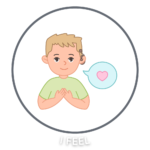
In the complex world of middle school, understanding and interpreting the feelings of others is not just a social skill—it is a critical educational objective. Special educators play a crucial role in teaching these skills, helping students navigate the emotional landscapes of both themselves and others. A particularly effective tool in this educational endeavor is the interactive worksheet “Understanding Feelings and Expressions,” designed to enhance students’ feeling identification through facial expressions. This blog post explores how this interactive activity can be integrated into classroom lessons to significantly improve emotional literacy among middle school students.
The Importance of Emotional Recognition in Middle School
The ability to recognize and interpret the emotional states of others through facial expressions and body language is a cornerstone of successful social interaction. For middle school students, particularly those in special education programs, mastering this skill can greatly enhance peer interactions, conflict resolution, and overall social participation. It forms the basis for empathy, which in turn, can reduce bullying and improve classroom dynamics.
Feeling Identification through Facial Expressions
“Understanding Feelings and Expressions” is an interactive matching activity specifically designed for middle school learners. It focuses on the critical social-emotional learning (SEL) skills of recognizing and responding to others’ emotions accurately by observing subtle cues in facial expressions and body language.
How the Worksheet Works
The activity presents students with a series feeling words and body clue descriptions. Students are tasked with matching these feeling words to the corresponding “clues”. This not only reinforces their ability to connect physical body language with emotional states but also encourages a deeper understanding of how emotions are communicated non-verbally.
Educational Benefits
- Enhanced Emotional Awareness: Students learn to pay close attention to the facial expressions and body movements that convey emotions, enhancing their ability to read these important social cues.
- Improved Empathy: By identifying what others might be feeling, students develop empathy, which is essential for fostering positive peer relationships and a supportive learning environment.
- Conflict Resolution Skills: Recognizing emotions accurately can help students navigate conflicts more effectively, as they are better equipped to understand the perspectives and feelings of others.

Implementing the Worksheet in Your Classroom
To effectively use the “Understanding Feelings and Expressions” worksheet in your classroom, consider the following strategies:
Interactive Group Activities
Organize small group sessions where students can discuss each body clue and collaboratively decide on the emotion it represents. This not only makes the activity more engaging but also promotes discussion and perspective-taking among students.
Role-Playing
Incorporate role-playing exercises where students act out different scenarios using the emotions they’ve matched from the worksheet. This helps solidify their understanding and gives them a chance to practice expressing and identifying emotions in a dynamic setting.
Continuous Reinforcement
Regularly revisit the concepts introduced in the worksheet throughout the school year to reinforce learning. Ensure that students continue to apply their knowledge in various contexts.
Unlock ALL of our Social Communication activities by signing up for your free trial today – no credit card required!
Access the full Social Communication Curriculum HERE!
Instant access to thousands of no-prep social skills activities, over 1000+ video lessons, and engaging games designed to enhance learning and development.
Conclusion
The “Understanding Feelings and Expressions” worksheet is an invaluable tool for middle school special educators. By supporting students in understanding feelings through body clues, educators can equip them with important social skills. As students become stronger at interpreting these non-verbal cues, they’ll see improvements in their emotional intelligence. All of this can transform how students interact with the world around them.
Sample Video
Students learn best from watching real students their own age model skills. Try out this sample video lesson. We offer our entire Social-Emotional Learning platform free for 14 days here!
Related Blog Posts:
Developing Focus and Organization: Free Executive Functioning Worksheets
Exploring the Benefits of Incorporating Executive Functioning Curriculum in High School Education
Building Skills: A Practical Approach to Executive Functioning Curriculum

